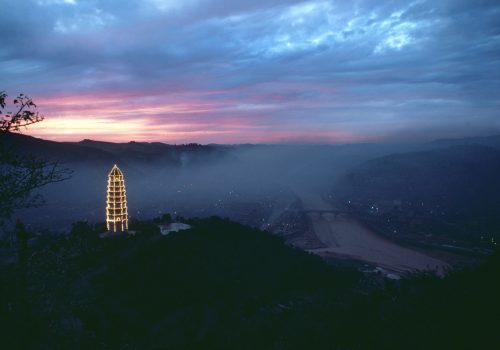When I learned in September 1985 I had been invited to retrace the footsteps of Mao Zedong and the Red Army, I started with my history books to review the details of Mao’s Long March, a decisive event in China’s history. I was immensely proud to be part of a project that would allow me to revisit that period which would radically change the lives of a third of humanity.
My previous work in the region explored the modernization of China in various provinces. I photographed the 35th Anniversary of the Chinese Revolution in Beijing amid the jubilant crowds and displays of industrial progress. I was so happy that only a year later I would get to see the other China: rural and archaic. While this was by no means my only trip to China, it stands out as one of my most memorable.
I was assigned to photograph the final portion of Mao’s Long March through China which ended in northern Shaanxi province in a little triangle formed by three small towns: Yan’an, Zhidan and Wuqi. It was there that Mao ended his 6,000-mile march from 1934 to 1935 and stayed until 1947. From his position tucked away in the caves of Yan’an, he consolidated his power and ended up driving both Chiang Kai-Shek and the Japanese from the country.
The region continues to be known as an important historical center of the Chinese Revolution, but stands out as one of the most impoverished and isolated regions of the country.
Rain followed me almost without let-up during the eight days I spent in the region and I felt guilty about having my guides carry such heavy bags through the mud and I insisted on carrying them myself. As I slogged through the mud, I saw buses, tractors, trucks and military Jeeps barring the road, buried up to the axels, and thought of the Red Army trekking the same route fifty years before.
The landscape is marked by cliffs that people hollowed out centuries ago and made into caves where they continue to live. The cave dwellings consist of only a main room with a curtained door and window covered with rice paper. Everything I saw inside these caves was a photographer’s delight: the antique sewing machines and looms, the cradle that had rocked generations of babies, the chickens and pigs that ran around our feet like pets, the donkeys that turned the stone mills to grind grain, the old women with their stunted feet, even school rooms with carved stone tables for the pupils. At another school I visited, the Nangui Primary School in Yan’an, the children raised their hands in unison for the morning ritual of saluting the flag, and this scene became one of my most iconic pictures. Along the way, I passed hillsides covered with buckwheat flowers, which were bordered by mobile beehives where honey was collected. I also visited a livestock market where negotiation was silent, in sign language only, and with their hands covered by a traditional cloth as had been done for centuries.
While I felt only welcoming from the people, I could never get a moment alone, not even to use the toilet, they all came to see me work, touch my beard and my big nose.
Later, when I met the Governor of Wuqi, he told me that I was the first Westerner to visit the region.
It was in Yan’an that I found Mao’s House: a simple, monastic cave with a bed, a table and two chairs. A bit further away, in another hole in the cliff, he took shelter from the Japanese bombardments. No sooner had I photographed this site than my guides took me to yet another cave that was yet another House of Mao. It became a running joke–he had lived everywhere, had been everywhere, with each cave becoming a sanctuary with its guardian, his wife and their kids. I visited dozens of them, with their whitewashed facades bearing a little red notice, very clean, giving the dates of his stay.
Knowing the reasons for my visit, the community elders came to introduce themselves, talking of their “March” and their experiences as soldiers in the Red Army and showing me photos and old letters. Here I was meeting those very survivors of the Long March, the pivotal event that had inspired a generation of Chinese through the historical tremors of the Cultural Revolution. It was all very moving.
It was among these villagers that Mao produced the bulk of his work, solidifying the power of Communism in China and his role as Supreme Leader. In a rain-drenched, far-flung province, I came to understand his legacy and what an honor it was for the people to hold a photograph in their hands, as a document of their presence at such a moment in history. What a privilege and immense honor it was for me, one of the first foreign visitors to Yan’an, to retrace Mao’s footsteps and help create another visual record of this pivotal era.
Jean-Pierre Laffont
These two exhibitions are curated by Jean Loh.
NEW YORK CITY UP AND DOWN
Shenzhen Photography Festival
LAFFONT’S LONG MARCH
Beaugeste Gallery in Shanghai
















